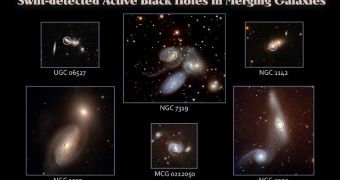Scientists at the American space agency say that they were finally able to answer a decades-old astronomical question. For years, astrophysicists have been trying to explain why a small portion of all black holes – no more than 1 percent – appear to emit vast amounts of energy at certain times. The behavior could not be accounted for until now, when data collected by the ongoing Swift mission revealed that the dark structure may in fact be activated by impressively-large galactic mergers, or collisions, NASA reports.
According to the science team, the new data could in the future be used to extract new knowledge on how the black hole at the core of our own Milky Way will evolve. This is a very interesting question, especially when considering that, about 2 billion years from now, our galaxy will collide with our closest neighbor, Andromeda. Given the impressive size of both structures, it stands to reason that the black holes at their cores will collide and maybe merge. This means that the resulting structure will also be a similar, larger formation that will be emitting vast amounts of energy, making it a part of this small minority.
“Theorists have shown that the violence in galaxy mergers can feed a galaxy's central black hole. The study elegantly explains how the black holes switched on,” says University of Maryland in College Park scientist Michael Koss, who was also the lead author of a new study detailing the findings. The paper is scheduled to be published in the upcoming June 20 issue of the esteemed Astrophysical Journal. The peculiar black holes are generally called active galactic nuclei (AGN), and they can sometimes emit about 10 billion times the amount of energy the Sun does.
“Building up its exposure year after year, the Swift BAT Hard X-ray Survey is the largest, most sensitive and complete census of the sky at these energies,” says the principal investigator of the SWIFt mission, Neil Gehrels. He holds an appointment at the Greenbelt, Maryland-based NASA Goddard Space Flight Center (GSFC). “The Swift BAT survey is giving us a very different picture of AGN. Perhaps 60 percent of these galaxies will completely merge in the next billion years. We think we have the 'smoking gun' for merger-Triggered AGN that theorists have predicted,” Koss concludes.

 14 DAY TRIAL //
14 DAY TRIAL //